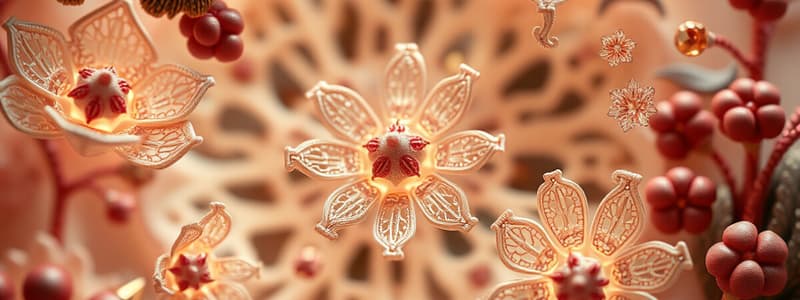Podcast
Questions and Answers
What is the primary feature of differential interference contrast (DIC) microscopy?
What is the primary feature of differential interference contrast (DIC) microscopy?
- It produces polarized light using a polarizer. (correct)
- It observes bacteria using bright-field microscopy.
- It requires the specimen to be stained for visualization.
- It uses a laser to create images.
How does DIC microscopy enhance the visualization of cellular structures?
How does DIC microscopy enhance the visualization of cellular structures?
- By emitting a laser that excites fluorescent dyes.
- By producing a three-dimensional perspective through interference. (correct)
- By flattening the cell structure into two dimensions.
- By using stained cells to highlight differences.
In what scenario is DIC microscopy typically utilized?
In what scenario is DIC microscopy typically utilized?
- For imaging internal fixed structures.
- For thick tissue sections.
- For observing live, unstained cells. (correct)
- For highly stained specimens.
What role does the prism play in DIC microscopy?
What role does the prism play in DIC microscopy?
What is a key characteristic of the confocal scanning laser microscope (CSLM)?
What is a key characteristic of the confocal scanning laser microscope (CSLM)?
What happens to cells when they are struck by the laser in CSLM?
What happens to cells when they are struck by the laser in CSLM?
What advantage does CSLM provide in comparison to traditional microscopy techniques?
What advantage does CSLM provide in comparison to traditional microscopy techniques?
How does the use of fluorescent dyes enhance imaging in CSLM?
How does the use of fluorescent dyes enhance imaging in CSLM?
What allows electron microscopes to achieve higher resolution compared to light microscopes?
What allows electron microscopes to achieve higher resolution compared to light microscopes?
Which component is primarily responsible for imaging in electron microscopes?
Which component is primarily responsible for imaging in electron microscopes?
What is the typical resolving power of a transmission electron microscope (TEM)?
What is the typical resolving power of a transmission electron microscope (TEM)?
Why do sections of cells need to be treated with stains before viewing with a TEM?
Why do sections of cells need to be treated with stains before viewing with a TEM?
What limitation does the electron beam have when imaging cells?
What limitation does the electron beam have when imaging cells?
What is an electron micrograph?
What is an electron micrograph?
What type of electron microscopy is primarily used for examining cells at very high magnifications?
What type of electron microscopy is primarily used for examining cells at very high magnifications?
What is the purpose of using stains like osmic acid or lead salts in electron microscopy?
What is the purpose of using stains like osmic acid or lead salts in electron microscopy?
Study Notes
Differential Interference Contrast (DIC) Microscopy
- DIC microscopy uses a polarizer in the condenser to generate polarized light.
- The polarized light passes through a prism, creating two distinct beams.
- These beams travel through the specimen and enter the objective lens, where they are combined.
- The interaction of beams, which pass through materials of different refractive indices, leads to interference and a three-dimensional perspective.
- This technique enhances subtle structural differences within cells, making features more visible than in standard light microscopy.
- Ideal for examining unstained cells, DIC microscopy effectively reveals internal structures often obscured in bright-field microscopy.
- Common applications include observing the nucleus in eukaryotic cells and various inclusions in bacterial cells.
Confocal Scanning Laser Microscope (CSLM)
- CSLM integrates a laser with a fluorescence microscope for high-contrast imaging.
- The laser enables the examination of multiple planes of focus within a specimen, enhancing depth perception.
- The laser beam is specifically focused to capture one layer of the specimen at a time, allowing detailed analysis.
- Cells illuminated by the laser fluoresce, producing images similar to traditional fluorescence microscopy.
- Specimens can be stained with fluorescent dyes to improve visibility of cellular structures.
- The laser scans the specimen in layers, generating a series of images for each focal plane.
- A computer compiles these images, resulting in a detailed, high-resolution, three-dimensional representation of the specimen.
- Particularly advantageous for analyzing thick specimens, such as bacterial biofilms, allowing visualization of cells within various layers, unlike conventional light microscopy.
Electron Microscopes Overview
- Utilize electrons instead of visible light (photons) for imaging cells and structures.
- Employ electromagnets as lenses and operate in a vacuum environment.
Electron Micrographs
- Electron microscopes are equipped with cameras to capture images, resulting in electron micrographs.
Types of Electron Microscopy
- Two main types used in microbiology:
- Transmission Electron Microscopy (TEM)
- Scanning Electron Microscopy (SEM)
Transmission Electron Microscope (TEM)
- Designed for high magnification and resolution.
- Resolving power is significantly greater than light microscopes.
- Capable of visualizing structures at the molecular level due to shorter electron wavelengths.
- Resolving power of TEM is approximately 0.2 nanometers, a thousandfold improvement over light microscopes (0.2 micrometers).
Sample Preparation for TEM
- Required to create thin sections (20-60 nm) of cells due to poor electron penetration.
- Cells are stabilized and stained with high atomic weight chemicals (e.g., osmic acid, uranium, lead salts) to enhance contrast by scattering electrons effectively.
Viewing Methods
- Internal cell structures necessitate thin sections, while external features can be observed directly via negative staining techniques in TEM.
Studying That Suits You
Use AI to generate personalized quizzes and flashcards to suit your learning preferences.
Description
Explore the advanced microscopy techniques of Differential Interference Contrast (DIC) and Confocal Scanning Laser Microscope (CSLM). This quiz covers how these methods enhance cellular imaging and reveal structural details not visible with standard microscopy. Test your knowledge on their principles and applications in biological research.




